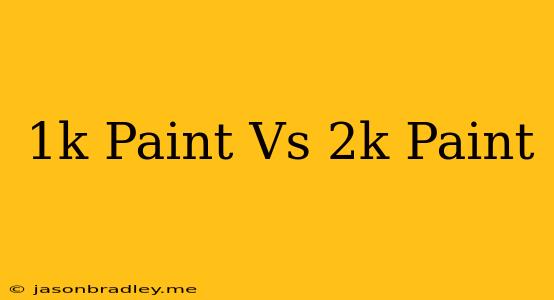1K vs 2K Paint: Choosing the Right Finish for Your Project
Choosing the right paint for your project can be a daunting task, especially when faced with options like 1K and 2K paints. Both offer distinct advantages and disadvantages, making it crucial to understand their differences to select the best fit for your needs.
What is 1K Paint?
1K paint, also known as single-component paint, is a simple, user-friendly option, especially for DIY projects. It consists of only one component, typically a pigmented resin mixed with a solvent. 1K paints are easy to apply, dry quickly, and are readily available at most hardware stores. They are often preferred for projects where a quick, low-maintenance finish is desired.
Here are some pros and cons of 1K paint:
Pros:
- Easy application: 1K paints are straightforward to use and require minimal preparation.
- Quick drying time: They dry quickly, allowing for faster project completion.
- Affordable: 1K paints are generally less expensive than 2K paints.
- Widely available: They are readily available at most hardware and paint stores.
Cons:
- Lower durability: 1K paints are less durable and resistant to scratches, UV damage, and chemicals compared to 2K paints.
- Limited color options: 1K paints offer a more limited range of color options than 2K paints.
- Lower gloss: 1K paints typically have a lower gloss finish compared to 2K paints.
What is 2K Paint?
2K paint, also known as two-component paint, is a more advanced option that offers exceptional durability and performance. It consists of two components: a base coat containing pigmented resin and a hardener. Mixing these components triggers a chemical reaction that forms a strong, durable coating. 2K paints are widely used in automotive and industrial applications due to their superior properties.
Here are some pros and cons of 2K paint:
Pros:
- Excellent durability: 2K paints are highly resistant to scratches, UV damage, chemicals, and wear and tear.
- Superior gloss: They offer a high-gloss finish that enhances the appearance of the painted surface.
- Wider color range: 2K paints provide a broader range of color options and special effects.
- Long-lasting protection: They offer long-lasting protection against environmental elements and corrosion.
Cons:
- Complex application: 2K paints require proper mixing and application techniques for optimal results.
- Shorter pot life: The mixed paint has a limited working time, requiring careful planning and execution.
- More expensive: 2K paints are generally more expensive than 1K paints.
- Specialized equipment: Applying 2K paints may require specialized equipment like spray guns and respirators.
Choosing the Right Paint: 1K or 2K?
Choosing between 1K and 2K paint depends on your specific needs and project requirements. Consider the following factors:
- Project type: For DIY projects like furniture or home décor, 1K paint is often sufficient. For automotive or industrial applications, 2K paint is recommended due to its durability.
- Durability requirements: If you require a highly durable finish, 2K paint is the best choice. For less demanding applications, 1K paint may suffice.
- Budget: 1K paints are generally more affordable than 2K paints. Consider your budget limitations when choosing.
- Skill level: 1K paints are easier to apply, making them suitable for beginners. 2K paints require more experience and knowledge for proper application.
Ultimately, the decision depends on your individual needs and priorities. Carefully weigh the pros and cons of each option before making your final choice.
